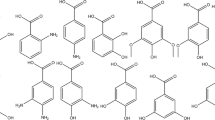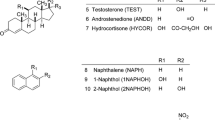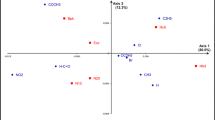Summary
Interpretive methods are very commonly used to direct the search for the optimum solvent composition. For multisolvent systems, the composition search space is often reduced to one straight line (ternary systems with two organic modifiers), three straight lines (three ternary systems with each possible pair of the organic modifiers of the tetrahedron) — or a plane delimited by a triangle (quaternary systems inside the solvent tetrahedron). In each case, the space is restricted by binary compositions of equal solvent strength, in such a way that through it, the analysis time remains approximately constant. This restricted space is defined without taking into account any selectivity criterion between peaks, and consequently, if a given pair of peaks is badly resolved with the considered binary solvents, the probability of any mixture of them improving the peak selectivity will be very low. The ability to calculate the retention models in a binary solvent system from two linear gradient runs, allows the prediction of the selectivity for each pair of solutes into each binary solvent system (ACN/Water, MeOH/Water, THF/Water) from six preliminary linear gradient runs, and then, to determine and eliminate all the sets of isoeluotropic binary compositions that will offer little hope of giving useful separation conditions with multisolvent systems and, at the same time, to select the most promising set of binary compositions. The selectivity and the total time of the chromatogram are the two parameters that are considered for this search. When several possiblities are found, priority is given to the simplest solvent system (binary rather than ternary and ternary rather than quaternary). Reducing the number of preliminary experiments and improving the accuracy of the predicted optimum are the two objectives of this approach. Its practical interest is discussed by comparing the results obtained for an illustrative separation to those obtained with another existing method.
Similar content being viewed by others
References
P. J. Schoenmakers, Optimization of chromatographic selectivity. Elsevier, Amsterdam (1986).
A. C. J. H. Drouen, H. A. H. Billiet, P. J. Schoenmakers, Chromatographia16, 48 (1982).
P. M. J. Coenegracht, H. J. Metting, A. K. Smilde, P. J. M. Coenegracht-Lamers, Chromatographia27, 135 (1989).
P. J. Naish-Chamberlain, R. J. Lynch, Chromatographia29, 79 (1990).
J. L. Glajch, J. J. Kirkland, K. M. Squire, J. M. Minor, J. Chromatogr.199, 57 (1980).
G. Mazerolles, D. Mathieu, R. Phan-Tan-Luu, E. M. Gaydou, A. M. Sioufft, Chromatographia485, 433 (1989).
S. Heinisch, P. Riviere, J. L. Rocca, Chromatographia32, 559 (1991).
S. Heinisch, P. Riviere, J. L. Rocca, Analusis20, 69 (1992).
S. Heinisch, J. L. Rocca, M. Feinberg, J. Chemometrics3, 127 (1988).
S. Heinisch, J. L. Rocca, Analusis18, 83 (1990).
J. C. Giddings, Anal. Chem.39, 1024 (1967).
P. J. Schoenmakers, H. Blaffert, J. Chromatogr.384, 117 (1987).
S. Heinsich, J. L. Rocca, M. Kolosky, Chromatographia29, 482 (1990).
P. M. J. Coenegracht, A. K. Smilde, H. J. Metting, D. A. Doornbos, J. Chromatogr.485, 195 (1989).
P. J. Schoenmakers, H. A. H. Biliet, L. de Galan, J. Chromatogr.205, 13 (1981).
P. J. Schoenmakers, H. A. H. Billiet, L. de Galan, J. Chromatogr.218, 261 (1981).
Author information
Authors and Affiliations
Rights and permissions
About this article
Cite this article
Heinisch, S., Riviere, P. & Rocca, J.L. Optimization of a multisolvent composition in RP-HPLC: Convenient criterion for preliminary search for the best eluent strength. Chromatographia 36, 157–163 (1993). https://doi.org/10.1007/BF02263854
Received:
Revised:
Accepted:
Issue Date:
DOI: https://doi.org/10.1007/BF02263854




